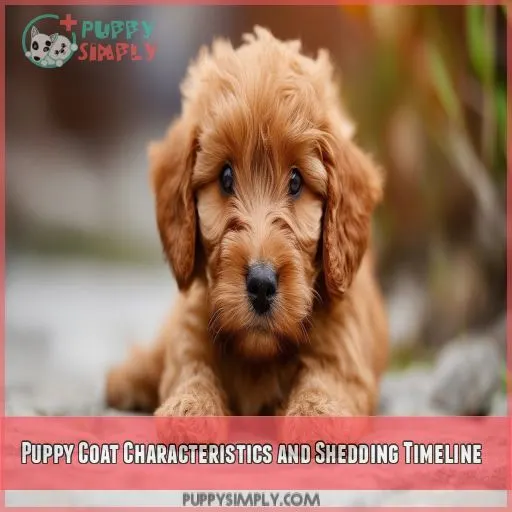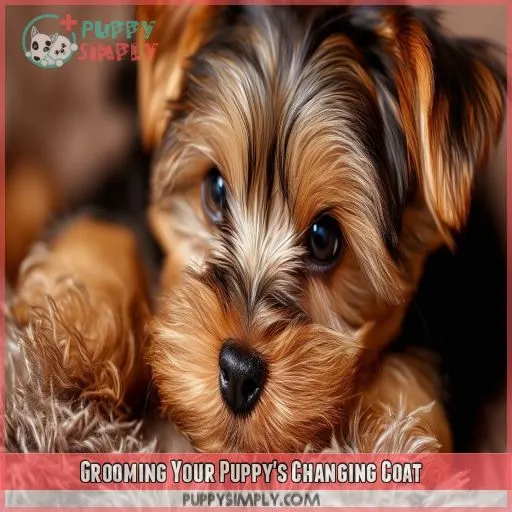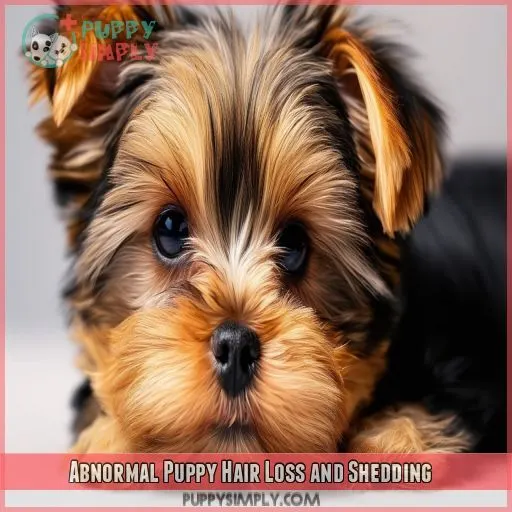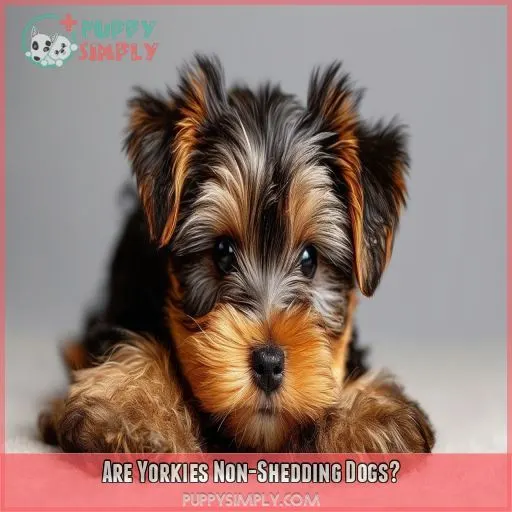This site is supported by our readers. We may earn a commission, at no cost to you, if you purchase through links.
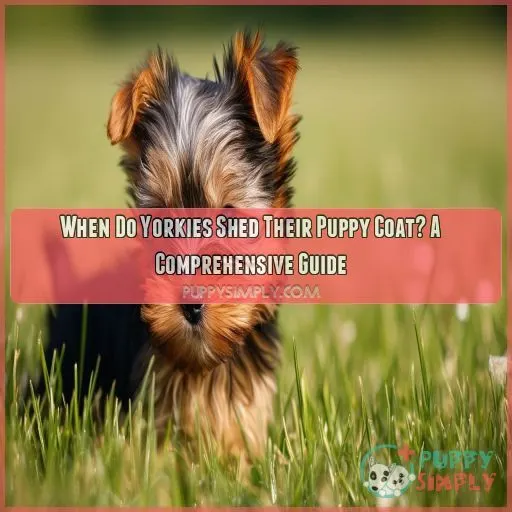 Yorkshire Terriers were the 6th most popular dog breed in America in 2020. As you welcome a Yorkie puppy into your home, you’ll want to understand the key milestones of their coat development, including when they shed their puppy coat and transition to their adult coat.
Yorkshire Terriers were the 6th most popular dog breed in America in 2020. As you welcome a Yorkie puppy into your home, you’ll want to understand the key milestones of their coat development, including when they shed their puppy coat and transition to their adult coat.
This comprehensive guide will walk you through the shedding timeline, grooming tips, and what to expect as your Yorkie’s coat changes over their first year.
Table Of Contents
- Key Takeaways
- When Do Yorkies Shed Their Puppy Coat ?
- Key Milestones in Puppy Coat Development: Weeks 1-12
- Key Milestones in Puppy Coat Development: Weeks 16-20
- Puppy Coat Characteristics and Shedding Timeline
- Grooming Your Puppy’s Changing Coat
- Abnormal Puppy Hair Loss and Shedding
- Are Yorkies Non-Shedding Dogs?
- Frequently Asked Questions (FAQs)
- How long does the puppy coat shedding process typically take?
- Are there any signs that indicate the start of puppy coat shedding?
- Does the puppy coat shedding affect the adult coat color?
- Can diet or supplements impact the puppy coat shedding timeline?
- Are there any grooming techniques to ease the puppy coat transition?
- Conclusion
Key Takeaways
- Yorkies begin shedding their puppy coat between 4 to 6 months of age, transitioning from a soft, fluffy coat to a finer, silkier adult coat without an undercoat.
- Regular grooming, including the use of appropriate brushes and gentle bathing with no-tears shampoo, is essential for managing shedding and ensuring a healthy coat transition.
- Abnormal hair loss in Yorkie puppies can be caused by factors such as poor diet, parasites, hormonal imbalances, or underlying health issues, requiring a comprehensive approach for diagnosis and treatment.
- Starting grooming routines early and being gentle during the process can help avoid stress for the puppy, contributing to a smoother coat transition and overall well-being.
When Do Yorkies Shed Their Puppy Coat ?
Yorkies shed their puppy coat around 6-8 months of age, as the black hair begins to transform into the blue and tan or blue and gold adult coat. This shedding process is not as noticeable as in other breeds due to the texture and rate of growth of the Yorkie’s hair.
Key Milestones in Puppy Coat Development: Weeks 1-12
As your Yorkie puppy grows, you’ll notice some key milestones in their coat development during the first 12 weeks. Between weeks 8-9, your pup will receive their first puppy shots, while weeks 9-10 mark the beginning of their color transition from black and tan to the signature blue and tan adult coat.
Weeks 8-9 – First Puppy Shots
At weeks 8-9, it’s time for your Yorkie’s first big adventure to the vet for puppy vaccinations. This crucial step shields them from nasties like Parvovirus and Distemper. It’s not just about health; it’s a milestone in their coat development journey. With a health certificate in paw, they’re ready to strut, their puppy coat beginning to hint at future changes.
Weeks 9-10 – Color Transition Begins
As your Yorkie puppy enters the second phase of coat development, around 9-10 weeks, you’ll start to notice color changes in their coat. The black color will begin to recede, making way for an increased presence of tan, particularly across the back and flanks. This color transition is a natural part of the Yorkie’s growth process, and it’s important to be patient and supportive during this time.
During this period, you’ll also start to see the first signs of silver or gold hair appearing on the top of your puppy’s head. This color transition continues, and by the time your puppy reaches adulthood, they’ll have a coat that isn’t only remarkable for its blue and tan (or blue and gold) colors but also silky texture.
To help your Yorkie’s coat transition smoothly, it’s crucial to establish a grooming routine early on. Start with a gentle brush designed for puppy coats, and be sure to use a no-tears shampoo to keep their skin healthy. Regular grooming sessions won’t only help remove dead hair but also ensure that your Yorkie’s coat remains healthy and shiny.
As your Yorkie’s coat changes, you may also notice some shedding, which is a normal part of the coat development process. However, it’s essential to monitor your puppy’s coat for any signs of excessive hair loss, as this could indicate potential health issues such as alopecia. If you notice bald patches, scaly skin, or inflammation, consult your veterinarian for a proper diagnosis and treatment plan.
Weeks 12-16 – Bring Puppy Home
As your Yorkie enters weeks 12-16, it’s time to bring your furry friend home. This is a crucial phase in your puppy’s life, as they transition from living with their littermates to becoming a part of your family.
During this period, you’ll need to focus on:
- Puppy care
- House training
- Feeding schedules
- Socialization
- Crate training
It’s essential to puppy-proof your home and find a vet to schedule their first shots. Remember, your Yorkie’s coat will start to shed, so be prepared for some changes.
Key Milestones in Puppy Coat Development: Weeks 16-20
Between weeks 16 to 20, Yorkies lose their fuzzy puppy fur, which is called felting. Within two weeks, the Yorkie’s fine, sleek hair begins to grow back.
Week 16 – Board Puppy for First Time
Week 16 marks a significant milestone in your Yorkie’s life. It’s time to board your puppy for the first time. This experience can be daunting, especially if your Yorkie is prone to separation anxiety. However, puppy boarding is crucial for their socialization and adaptation to new environments.
Weeks 16-20 – Color Transition Mostly Complete
As your Yorkshire terrier steps into weeks 16-20, you’ll notice the color changes nearing completion, a sign they’re embracing their newfound freedom.
It’s a perfect time for puppy socializing and advanced training, enhancing their zest for life.
Their first grooming session not only tidies them up but also introduces them to the joys of boarding, making every experience a step towards liberation.
Puppy Coat Characteristics and Shedding Timeline
As your Yorkie puppy grows, you’ll notice some changes in their coat. Understanding these changes can help you navigate the complexities of your Yorkie’s coat development.
First, know that Yorkies don’t have an undercoat, which means they shed less than other breeds. However, they do have a single coat that can be fine and silky. The Yorkie’s coat may change in color and texture as they grow, transitioning from a soft, fluffy puppy fur to a thicker, stiffer adult coat.
This shedding typically occurs between 4-6 months, but can vary by breed. Longhaired breeds may shed more visibly, while shorthaired dogs often have denser coats. Non-shedding breeds shed minimally as puppies, but all dogs shed to some extent.
To help your Yorkie maintain a healthy coat, regular grooming is essential. Use appropriate brushes for your Yorkie’s coat type and start grooming early, being gentle to avoid causing stress or discomfort. Bathing and using no-tears shampoo can also help remove dead hair and keep your Yorkie’s coat looking its best.
Grooming Your Puppy’s Changing Coat
As your Yorkie grows, it’s crucial to keep up with their evolving coat. Puppy coat care is about more than just keeping your furry friend looking good. It’s about their health, too.
The texture of your Yorkie’s coat will change as they grow, becoming thicker and stiffer. This transition can be challenging, especially if your Yorkie is prone to allergies. Regular grooming is essential to maintain your Yorkie’s coat and manage any potential allergies.
Use appropriate brushes for your Yorkie’s coat to avoid damaging their skin. Start grooming early and be gentle. Bathing helps remove dead hair and keeps your Yorkie’s coat healthy. Use no-tears shampoo to prevent irritation.
As your Yorkie sheds, it’s important to monitor their coat for any signs of abnormal hair loss. Excessive hair loss may indicate a health issue, such as alopecia. If you notice bald patches, scaly skin, or inflammation, consult your vet.
Abnormal Puppy Hair Loss and Shedding
- Understand the Causes: Abnormal shedding can be due to various factors such as poor diet, parasites, hormonal imbalances, or underlying health issues. Identify the root cause to provide the appropriate treatment.
- Symptoms: Pay attention to symptoms like excessive hair loss, scaly skin, and inflammation. These could indicate alopecia or other health problems.
- Diagnosis: A veterinarian can diagnose the cause of excessive shedding through physical examination, blood tests, and skin scrapings.
- Treatment: Depending on the cause, treatment may include improving your dog’s diet, administering medication, or addressing underlying health issues.
Are Yorkies Non-Shedding Dogs?
Yorkies aren’t non-shedding dogs, but they don’t have an undercoat like other breeds. Doodles, which are crossbreeds of Poodles and other breeds, are often touted as hypoallergenic and low-shedding, but this isn’t always the case.
Do Non-Shedding Dogs Exist?
| Non-Shedding Breeds | Hypoallergenic Dogs | Allergies and Dogs |
|---|---|---|
| Yorkies | Poodles | Less dander |
| Maltese | Bichons | Healthier homes |
| Schnauzers | Lagotto Romagnolo | Freer breathing |
| Shih Tzu | Portuguese Water Dog | Joy without sneezes |
Are Doodles the Answer to Shedding?
Are Doodles the Answer to Shedding?
If you’re looking for a low-shedding dog, Doodles might just be the answer. Doodles are a mix of Poodles and other breeds, and they inherit the Poodle’s low-shedding coat. However, it’s important to remember that no dog is 100% non-shedding, and individual Doodles can vary in shedding tendencies.
Doodles are often considered hypoallergenic, as they produce less of the dander responsible for allergic reactions. But, like all dogs, they can still cause allergic reactions due to dander, skin, saliva, and urine. If you’re considering a Doodle, it’s crucial to spend time with the parents and visit them in their home to ensure you won’t have an allergic reaction.
When it comes to grooming, Doodles require regular maintenance, including daily brushing and occasional visits to the groomer or home clipping sessions. This helps reduce tangles, spread natural oils, and remove dead hair.
In summary, while Doodles can be a good choice for those with allergies or who want a low-shedding dog, it’s essential to understand that they still have the potential to cause allergic reactions and require regular grooming.
8 Tips to Lessen Allergies to Dogs!
To tackle allergies from pet dander, consider these 8 tips:
- Frequent grooming with suitable equipment
- HEPA filters for cleaner air
- Daily pet wipe-downs
- Limited pet access to certain areas
- Regular carpet and furniture cleaning
These steps can help reduce allergy triggers and manage reactions effectively. Remember, a little effort in grooming and cleaning can go a long way in creating a comfortable environment for both you and your furry friend!
Frequently Asked Questions (FAQs)
How long does the puppy coat shedding process typically take?
The puppy coat shedding process typically takes 4-6 months, though it can vary by breed. Some pups may start shedding as early as 12 weeks, while others wait until they’re a year old. Be patient – it’s a natural part of their growth.
Are there any signs that indicate the start of puppy coat shedding?
Yorkies typically start shedding their puppy coats when they’re between 4-6 months old. However, the shedding process can vary widely depending on the breed, with some breeds like Pomeranians taking up to 2 years to grow their adult coats.
During this period, Yorkies may experience changes in coat color and patterns as they transition from their puppy coat to their adult coat.
Regular grooming is essential to manage shedding and ensure the health of your Yorkie’s coat.
Does the puppy coat shedding affect the adult coat color?
Yes, shedding the puppy coat can affect the adult coat color, often revealing a richer, true hue as the mature coat comes in, much like a caterpillar’s transformation into a vibrant butterfly.
Can diet or supplements impact the puppy coat shedding timeline?
When it comes to your Yorkie’s coat shedding, there are a few factors to consider.
The first is the age of your Yorkie. Yorkies typically start shedding their puppy coat between 4-6 months of age, but this timeline can vary depending on the individual dog.
The second factor is diet. A balanced diet that provides the necessary nutrients for skin and coat health can help maintain a healthy coat and reduce shedding. Additionally, certain supplements, such as Omega-3 and Omega-6 fatty acids, biotin, vitamin E, and zinc, can support skin and coat health and potentially reduce shedding.
It’s always best to consult with your vet before introducing any new supplements to your pet’s diet to ensure it’s a good fit for their specific needs.
Are there any grooming techniques to ease the puppy coat transition?
When it comes to Yorkies and their coat transition, there are a few things to keep in mind. Yorkies don’t have an undercoat, so they don’t experience the same type of coat change as double-coated breeds. Instead, they’ve fine, silky hair that may change color as they grow into their adult coat. This process typically starts around 4-6 months of age, but it can vary depending on the individual dog.
To ease the puppy coat transition, regular grooming is essential. Start with a soft brush designed for puppy coats and be gentle to avoid causing discomfort or stress. Bathing your Yorkie with a no-tears shampoo can also help remove dead hair and keep their coat clean and healthy. As your Yorkie grows into their adult coat, you may need to switch to a different type of brush or grooming tool to manage their shedding patterns effectively.
Remember that Yorkies aren’t non-shedding dogs, but they don’t shed as much as some other breeds. However, they still require regular grooming to keep their coat healthy and looking its best. By following these tips and being patient during the transition, you can help your Yorkie grow into a beautiful, healthy adult with a lovely coat.
Conclusion
As the seasons cycle, so too does your Yorkie’s coat, transitioning from the soft fluff of puppyhood to the sleek sheen of maturity. By the time they shed their puppy coat, you’ll have witnessed a remarkable transformation.
Regular grooming is key to maintaining their lustrous locks. Embrace each stage with care, and you’ll ensure your furry companion shines at their best, reflecting the love and attention you’ve invested in their well-being.



